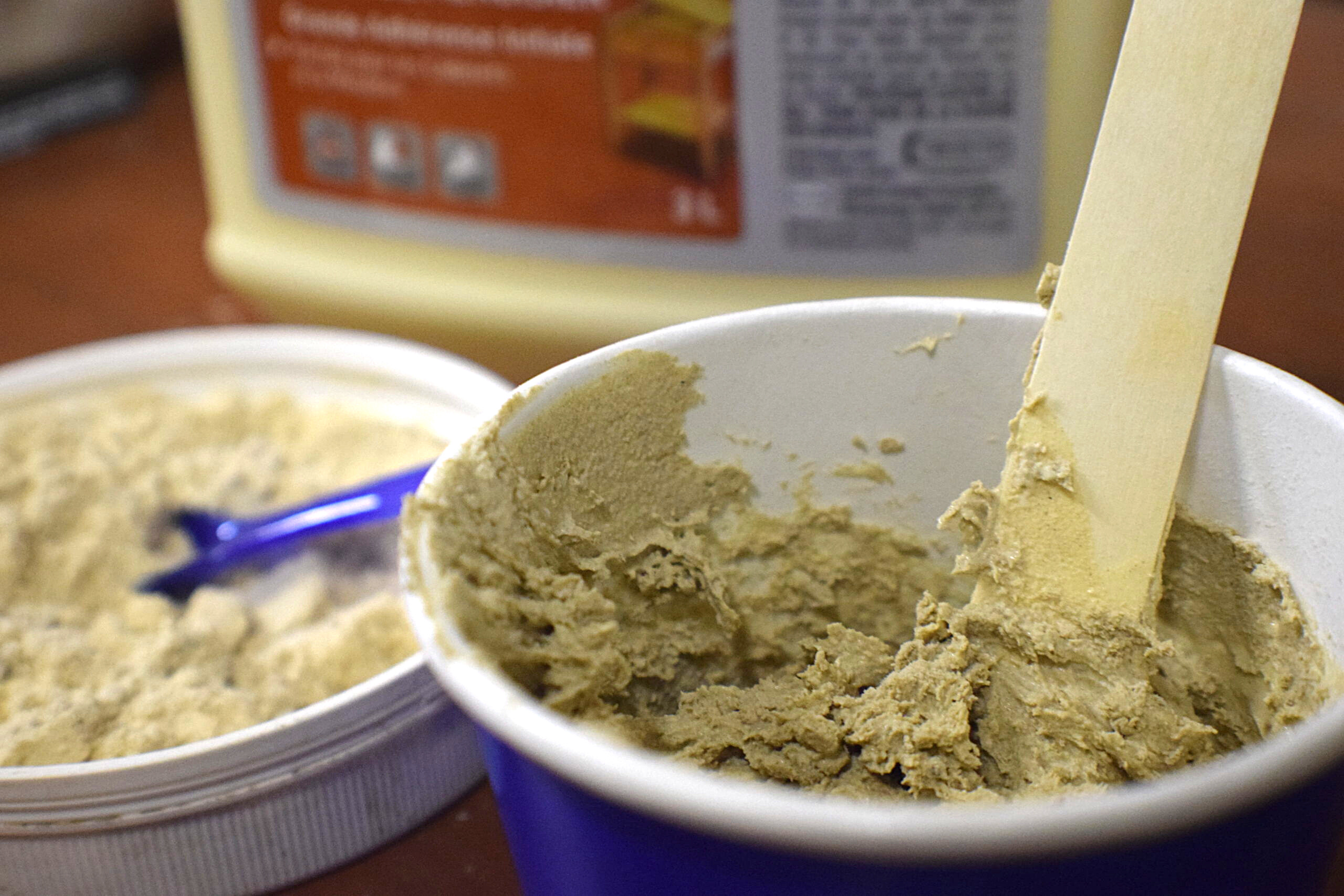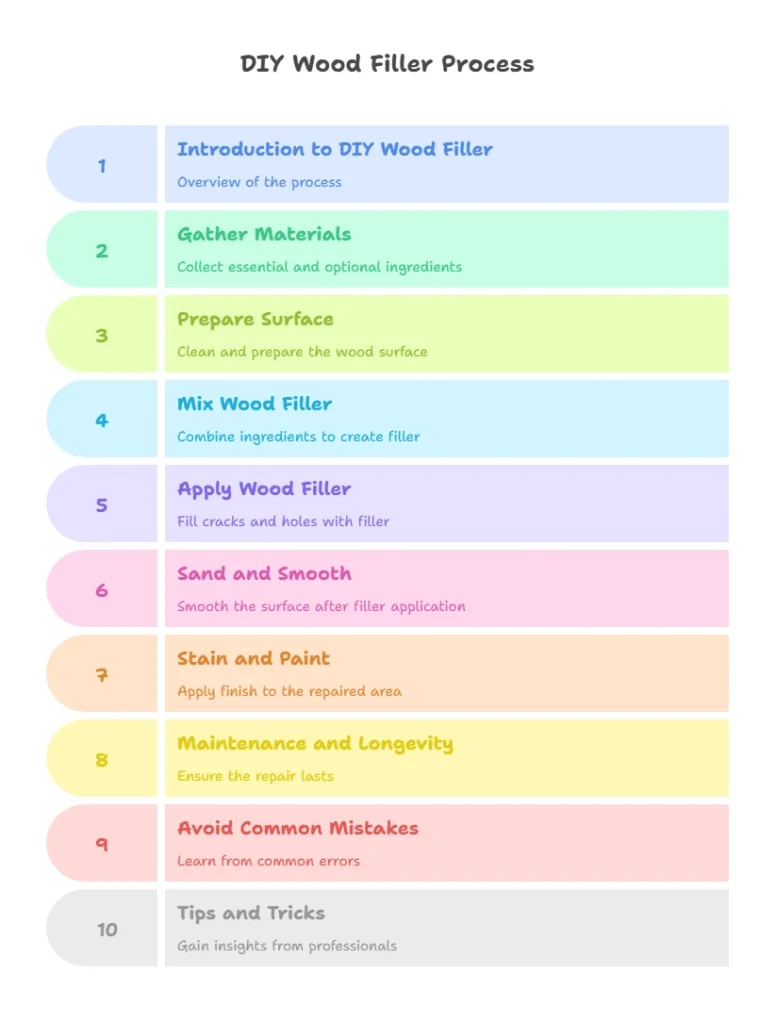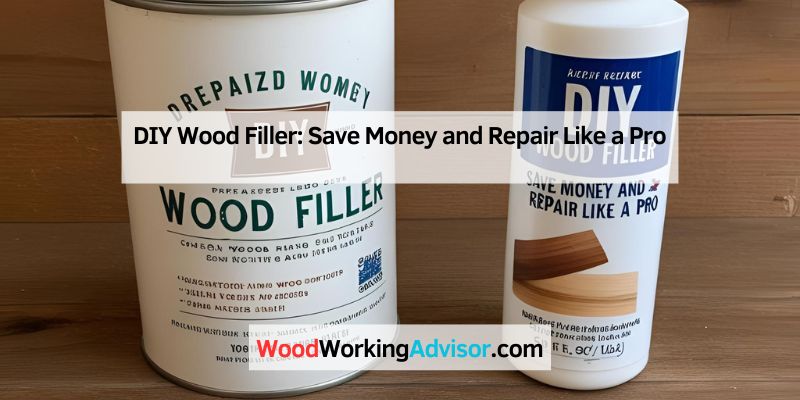Wood fillers can be a lifesaver for fixing holes and cracks in wood. Many store-bought options exist, but did you know you can make your own?
Creating your own wood filler is not only cost-effective but also satisfying. Imagine having the perfect blend that matches your project perfectly. DIY wood fillers are simple to make with materials you likely already have at home. This allows you to repair furniture, floors, or any wooden item with ease.
The process is straightforward and doesn’t require any special skills. Plus, you get the added benefit of knowing exactly what goes into your filler, ensuring it’s safe and effective. Ready to dive in? Let’s explore how you can make your own wood filler and tackle those wood repairs like a pro.
Introduction To DIY Wood Filler
Wood filler is a material used to fill holes and cracks in wood. It can make old wood look new again. It is a paste that hardens when dry. Many use it to repair furniture and floors. It is very useful for small repairs.
Making your own wood filler is cost-effective. You can save money. It is also customizable. You can match it to your wood. This is hard with store-bought fillers. Another benefit is that it is eco-friendly. You use less plastic packaging. It is also satisfying to make something yourself.

Materials Needed
You will need sawdust, wood glue, and a mixing container for DIY wood filler. A putty knife is also useful for application.
Essential Ingredients
To make wood filler, you need some basic items. Wood glue is the main ingredient. Sawdust or wood shavings are mixed in. These two items are key.
Optional Additives
You can add other things to improve the filler. Pigment can change the color. Sand helps with texture. Water may be used to thin the mixture. These additives are not required but can be useful.
Preparing The Surface
First, remove all dirt and dust. Use a damp cloth. Wipe the area gently. Let it dry completely. This step ensures the wood filler sticks well.
Next, sand the area with medium-grit sandpaper. This creates a rough surface. It helps the wood filler to adhere better. Sand in small, circular motions. After sanding, wipe away the dust again. The area is now ready for wood filler.
Mixing The Wood Filler
Start by gathering your materials. You will need sawdust and glue. Measure equal parts of sawdust and glue. Combine them in a bowl. Use a stirring tool to mix them well. The mixture should be thick and sticky. If it’s too dry, add more glue. If it’s too wet, add more sawdust.
The filler should be easy to spread. But it should not be runny. It needs to fill gaps and holes without dripping. Test the consistency by spreading a bit on scrap wood. Adjust if necessary. Mix until you get a smooth texture. Aim for a paste-like feel. This ensures it fills gaps perfectly.
Applying The Wood Filler
First, gather the wood filler and putty knife. Scoop a small amount of filler onto the knife. Spread the filler into the crack. Press down firmly. Smooth the surface with the knife. Remove any excess filler. Let it dry completely.
For deep cracks, use a bit more filler. Apply it in layers. Fill the crack halfway. Let it dry. Add another layer until the crack is full. Smooth the surface. Make sure each layer dries before adding more.

Credit: www.youtube.com
Sanding And Smoothing
Choosing the right sandpaper is crucial. Start with coarse sandpaper to remove large bumps. Then, move to medium grit for a better finish. Finally, use fine sandpaper for a smooth surface. Always sand in the direction of the wood grain. This avoids scratches. Also, change sandpaper if it gets clogged. Keeping it clean ensures better results.
Use light pressure when sanding. This keeps the wood surface even. Over-sanding can damage the wood. Use a sanding block for flat areas. It helps to apply even pressure. For curves and edges, use flexible sandpaper. Always check your work under good light. This helps to spot any rough areas. Sand again if needed.
Staining And Painting
Finding the right stain is important. It should match the wood color closely. Use a small piece of wood for testing. Apply the stain on the test wood. Let it dry fully. Check the color and adjust if needed. This will ensure the filler blends well.
Start with a clean surface. Sand the area first. Apply the paint or stain evenly. Use a brush for small areas. A roller works well on large surfaces. Let the first coat dry. Apply more coats if needed. This makes the finish smooth and even.

Credit: pineandpoplar.com
Maintenance And Longevity
Check your wood filler often. Look for cracks or gaps. These can weaken the wood. Regular checks help catch problems early. Fix small issues before they grow.
Sometimes, old filler wears out. Reapply wood filler if needed. First, remove the old filler. Clean the area well. Then, apply a fresh layer. Let it dry completely. This keeps the wood strong and looking good.
Common Mistakes To Avoid
Overfilling cracks can make your work look messy. It is important to fill cracks carefully. Use just enough filler to cover the gap. Too much filler can cause problems later. It might shrink and crack again. Be precise with the amount you use. Smooth out the filler gently. This will make your work look clean and neat.
Sanding is a key step in wood filling. Skipping this step can ruin your project. Sanding helps to smooth out rough spots. It makes the surface even. Without sanding, the filler may look bumpy. Always sand after filling the cracks. Use fine sandpaper for the best results. Sanding also helps the paint or stain stick better.

Credit: www.manmadediy.com
Tips And Tricks From The Pros
Mixing wood dust with glue creates a strong filler. Choose dust that matches the wood. This keeps the repair less visible. Collect dust from sanding. Use it right away for the best results. Combine the dust and glue well. The mixture should be thick like dough. Apply it to the gap or hole. Smooth it with a putty knife. Let it dry completely.
Epoxy adds extra strength to wood filler. Use it for big repairs. Mix epoxy and wood dust together. Follow the instructions on the epoxy package. Wear gloves to protect your hands. Apply the mixture to the damaged area. Shape it quickly before it hardens. Sand it smooth once dry. The repair will be very strong.

Frequently Asked Questions
What Can You Use As A Substitute For Wood Filler?
You can use epoxy, caulk, or a mixture of sawdust and glue as substitutes for wood filler. These options fill gaps effectively.
Can I Make My Own Wood Filler?
Yes, you can make your own wood filler. Mix sawdust with wood glue to create a paste. Apply it to the damaged area, let it dry, then sand it smooth. This DIY solution is effective and cost-efficient.
What Can Be Used For Wood Filler?
Wood filler options include epoxy, wood putty, and sawdust mixed with glue. Choose based on the repair needed.
How Do You Fill Wood Without Wood Filler?
Use a mixture of sawdust and wood glue. Apply the paste to the crack or hole, then sand it smooth.
Conclusion
Creating your own wood filler is simple and cost-effective. With just a few materials, you can fix small wood damages. No need for expensive store-bought fillers. DIY wood filler blends well with existing wood. It’s handy for quick repairs. Plus, it dries fast and lasts long.
Try this method next time you need to fill gaps or cracks. You’ll be amazed at the results. Happy woodworking!

